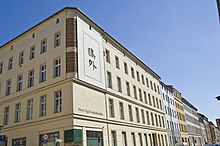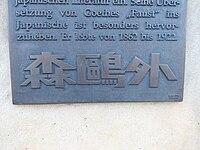Mori Ōgai
Mori Ōgai ( Japanese 森 鷗 外 ; * as Mori Rintarō on February 17, 1862 in Tsuwano ; † July 9, 1922 in Tokyo ) was a Japanese military doctor, poet and translator. Ōgai ("Seagulls") is his author's name, which he used from 1885 to 1913 with interruptions. His family name is Mori, his personal name Rintarō ( 林太郎 ).
Childhood and youth
Mori Ōgai (Mori Rintarō) was born in the castle town of Tsuwano, capital of the Principality of Tsuwano , in the southwestern Japanese province of Iwami (now Shimane Prefecture ) as the first son of Mori Mineko and the princely personal physician Mori Shizuo. The foundations of his education were laid in the local princely school Yōrō-kan ( 養老 館 , "Academy Care of the Elderly"). This included the study of Confucian scriptures, riding, archery, sword and lance fighting. In addition, he acquired basic knowledge of "Dutch Studies" ( Rangaku ) in private lessons . In the summer of 1872, d. H. only a few years after the last Tokugawa shogun, Yoshinobu, was dismissed, his father went with him to Tokyo (formerly Edo) to enable him to be trained according to the new medical standards. Because the new government had declared German medicine to be a binding model for training and practice in 1870, but implementation in the regions took some time. During these years Rintaro lived with his uncle Nishi Amane , who is considered the founder of modern Japanese philosophy . From 1874 he attended the preparatory course of the later medical school in Tokyo, from which the medical faculty of today's Tokyo State University emerged . At the same time he continued to study the classical literature of China and Japan, but also European literature, which he got to know mainly through German.
His academic teachers include some of the founders of modern medicine in Japan: the surgeons Leopold Müller, Wilhelm Schultze, and the internist Erwin von Baelz . Mori completed his medical studies begun in 1877 at the age of 19 and then served as a military doctor .
Study abroad
From 1884 to 1888 he studied hygiene and military medical services in Leipzig, Dresden, Munich and Berlin as a government scholarship holder, among others with Robert Koch and Max von Pettenkofer . In addition, he dealt intensively with European literature, religion, philosophy, music and art. His German diary ( 独 逸 日記 Doitsu nikki ), which is available in translation, gives a vivid impression of this period .
In 1886 an article published in the Allgemeine Zeitung by the geologist Heinrich Edmund Naumann, who had returned from Japan, caught his attention. Mori wrote a multi-page replica, which the editors printed immediately. The dispute was continued by Naumann and ended in February 1887 with a final reply from Mori. Although this was able to clear up various misunderstandings, he had a harder time with Naumann's accusation that Japan was copying the West without a deeper understanding of the background and at the same time seriously weakening itself by disregarding its own history and culture. He was to take up this topic again later.
military service
Back in Japan, Mori advanced to senior physician general in the army over the next two decades. At the beginning of the Sino-Japanese War (1894–1895) he was in Manchuria , and in Taiwan the following year. From 1899 he served in Kokura on Kyūshū , in 1902 he was transferred to Tokyo.
In the Russo-Japanese War (1904-1905) Mori came again to Manchuria. Strongly influenced by the German school, he refused to accept beriberi as a vitamin deficiency disease, although the chief doctor of the Navy, Takaki Kanehiro , was already on the right track and had achieved great success by changing the board food. Mori's view resulted in 27,000 beriberi deaths and 47,000 combat deaths. After retiring from military service (April 1916), he became Director General of the Imperial Libraries and Museums (December 1917). He was also chairman of the Japanese Academy of Arts from 1919 until his death in 1922.
Literary work
Mori made his debut in the intellectual life of his home country with his “three German novels”, in which he dealt with events from the study visit. The story Die Tanzprinzessin ( 舞 姫 Maihime , 1890) became particularly famous . In it he describes the failing love affair of a Japanese man in Berlin. In Japan also very popular and well known is the amendment wave foam ( うたかたの記 Utakata no ki , 1890) - still looking for Japanese tourists to Lake Starnberg specifically because of this amendment on.
The 38-volume complete edition of his work includes diaries and letters as well as medical, historical, cultural and literary work (including poetry, dramas and narrative literature) translations by Clausewitz , Goethe , Heine , ETA Hoffmann , Ibsen , Kleist , Knigge , Camille Lemonnier , Lessing , Schiller , Strindberg and many others.
In 1885 he visited Auerbach's cellar on December 27th while studying in Germany . Here he was encouraged to translate Goethe's Faust I and Faust II into Japanese. In his diary he wrote that for fun he had agreed to translate Faust . Its translation, which is still valid today, was printed in 1913. In 2009, the large painting Mori Ogai remembers December 27, 1885 in Auerbach's cellar by the painter Volker Pohlenz was unveiled in Auerbach's cellar .
Descendants
Mori died on July 9, 1922. He had four children: from his first marriage Otto ( 於 菟 , Oto ; 1890–1967, doctor), from his second marriage to Mori Shigeko (née Araki, 1880–1936) the daughters Marie ( 茉莉 , Mari ; 1903–1987, writer) and Anne ( 杏 奴 , Annu , married Kobori ( 小 堀 ); 1909–1998, writer) and Louis ( 類 , Rui ; 1911–1991, writer). His son Fritz ( 不 律 , Furitsu ), born in 1907, died just four months after he was born.
Positioning in Japanese modernism
Because of his ability to combine Japanese and Chinese with European education and against this background - as a civil servant and man of letters - to correspond to what Goethe calls “demands of the day” in maxims and reflections , he is considered one of the exemplary personalities of Japan at the beginning of the Modern. Until the end of the twentieth century, some knowledge of his work was part of the basic school knowledge. The Japanese literary scholar Kotani Yukio compares Mori Ōgai with Alphonse Daudet .
Memorial sites in Germany
The Mori-Ôgai memorial has been in existence in Berlin-Mitte , at the corner of Luisenstrasse and Marienstraße, since 1989 . It began in 1984 as a memorial room by the Humboldt University , supported by government agencies of the GDR and Japan. The Japanologist Beate Wonde, member of the board of the Japanese Mori -gai Society, has been looking after this institution since 1984. Interested parties can familiarize themselves with the work of the doctor and writer during opening hours.
In 2007 , a bust was installed in the castle garden of Döben Castle in memory of his stay in Saxony.
In Machern, east of Leipzig, there is a water feature on the market (designed by Maria Ondrej ), with one of the memorial plaques dedicated to the Japanese poet Mori Ōgai, who visited Machern in 1885. In Mutzschen, east of Leipzig, too , a plaque commemorates his time in the town, and part of the exhibition in the city museum is dedicated to him.
Works
- Germany diary 1884–1888 ( 独 逸 日記 , Doitsu nikki). ISBN 3-88769-063-X
- Utakata no ki ( う た か た の 記 , 1890), German wave foam
-
Maihime ( 舞 姫 , 1890), German The Ballet Girl , translated by Jürgen Berndt. Japan edition by be.bra Verlag, Berlin 2014, ISBN 978-3-86124-919-1 .
- dt. the dancer (and other stories). Tokyo 1971, ISBN 3-518-22159-0
- Fumizukai ( 文 づ か ひ , 1891), Ger . The messenger
- Wita sekusuarisu ( ヰ タ ・ セ ク ス ア リ ス , 1909), German Vita sexualis . ISBN 3-518-01813-2
- Under renovation (普 請 中, 1910). ISBN 3-458-16015-9
- His ( 青年 , 1910), German youth
- Gan ( 雁 , 1911–13), Ger. The wild goose . ISBN 3-518-01862-0
- Abe Ichizoku ( 阿 部 一族 , 1913), Eng. The Fall of the House of Abe
- Sanshō Dayū ( 山椒 大夫 , 1915), filmed as Sansho Dayu - A life without freedom
-
Takasebune ( 高 瀬 舟 , 1916)
- dt. The escort ship Takasabune , translated by Kakuji Watanabe. In: Japanese Masters of the Story , Walter Dorn Verlag, Bremen, 1960, pp. 29–38.
bibliography
- Mori Ôgai. A Bibliography of Western-Language Materials . Compiled by Harald Salomon. Incorporating the Findings of Rosa Wunner in Japonica Humboldtiana 2 (1998), Wiesbaden: Harrassowitz Verlag, 2008. 178 p., 1 fig. (Izumi 10)
Individual evidence
- ↑ Christoph degree man : Mori Ogau. In: Werner E. Gerabek , Bernhard D. Haage, Gundolf Keil , Wolfgang Wegner (eds.): Enzyklopädie Medizingeschichte. De Gruyter, Berlin / New York 2005, ISBN 3-11-015714-4 , p. 1009.
- ↑ Land and people of the Japanese chain of islands. Supplement to the Allgemeine Zeitung, No. 175 (June 26, 1886), 178 (June 29, 1886).
- ↑ Rintaro Mori: The Truth About Nipon. Supplement to Allgemeine Zeitung, No. 179 (June 30, 1886)
- ↑ The Dancer , feature film, directed by Masahiro Shinoda , coproduction Japan / Germany 1988. In: filmportal.de , accessed on November 17, 2018.
- ↑ Manfred P. Bläske: Mori Ôgai - "Lessing Japans" and President of the Art Academy on kvs-sachsen.de
- ^ Yukio Kotani : Ôgai to Dôde. (Ogai Mori et Alphonse Daudet. Étude documentaire), Hikaku bungaku kenkyu - Etudes de littératures comparées 6 (1957), 4, 7, pp. 138-145
- ↑ Beate Wonde's career. Website of the Institute for Asian and African Studies at the Humboldt University in Berlin
- ↑ http://home.uni-leipzig.de/mielke/machern/vorbild/vorbild4.html
Web links
- Literature by and about Mori Ōgai in the catalog of the German National Library
- Literature by Mori Ōgai in Aozora Bunko (Japanese)
- Mori-Ōgai Memorial Berlin
| personal data | |
|---|---|
| SURNAME | Mori, Ōgai |
| ALTERNATIVE NAMES | 森 鷗 外 (Japanese); Mori Rintaro |
| BRIEF DESCRIPTION | Japanese doctor and man of letters |
| DATE OF BIRTH | February 17, 1862 |
| PLACE OF BIRTH | Tsuwano |
| DATE OF DEATH | July 9, 1922 |
| Place of death | Tokyo |






